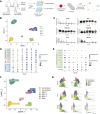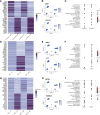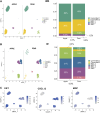Distinct subpopulations of human subcutaneous adipose tissue precursor cells revealed by single-cell RNA sequencing
- PMID: 38581663
- PMCID: PMC11193533
- DOI: 10.1152/ajpcell.00726.2023
Distinct subpopulations of human subcutaneous adipose tissue precursor cells revealed by single-cell RNA sequencing
Abstract
Adipose-derived stem cells (ADSCs) play an important role in the differential capacity for excess energy storage between upper body abdominal (ABD) adipose tissue (AT) and lower body gluteofemoral (GF) AT. We cultured ADSCs from subcutaneous ABD AT and GF AT isolated from eight women with differential body fat distribution and performed single-cell RNA sequencing. Six populations of ADSCs were identified and segregated according to their anatomical origin. The three ADSC subpopulations in GF AT were characterized by strong cholesterol/fatty acid (FA) storage and proliferation signatures. The two ABD subpopulations, differentiated by higher expression of committed preadipocyte marker genes, were set apart by differential expression of extracellular matrix and ribosomal genes. The last population, identified in both depots, was similar to smooth muscle cells and when individually isolated and cultured in vitro they differentiated less than the other subpopulations. This work provides important insight into the use of ADSC as an in vitro model of adipogenesis and suggests that specific subpopulations of GF-ADSCs contribute to the more robust capacity for GF-AT to expand and grow compared with ABD-AT in women.NEW & NOTEWORTHY Identification of distinct subpopulations of adipose-derived stem cells (ADSCs) in upper body abdominal subcutaneous (ABD) and lower body gluteofemoral subcutaneous (GF) adipose tissue depots. In ABD-ADSCs, subpopulations are more committed to adipocyte lineage. GF-ADSC subpopulations are enriched for genes involved in lipids and cholesterol metabolism. Similar depot differences were found in stem cell population identified in freshly isolated stoma vascular fraction. The repertoire of ADSCs subpopulations was different in apple-shaped versus pear-shaped women.
Keywords: abdominal adipose tissue; adipose-derived stem cells; cell identity; gluteofemoral adipose tissue; scRNA-seq.
Conflict of interest statement
No conflicts of interest, financial or otherwise, are declared by the authors.
Figures







Similar articles
-
Transcriptional and DNA Methylation Signatures of Subcutaneous Adipose Tissue and Adipose-Derived Stem Cells in PCOS Women.Cells. 2022 Mar 1;11(5):848. doi: 10.3390/cells11050848. Cells. 2022. PMID: 35269469 Free PMC article.
-
Differential open chromatin profile and transcriptomic signature define depot-specific human subcutaneous preadipocytes: primary outcomes.Clin Epigenetics. 2018 Nov 26;10(1):148. doi: 10.1186/s13148-018-0582-0. Clin Epigenetics. 2018. PMID: 30477572 Free PMC article. Clinical Trial.
-
Unique role for lncRNA HOTAIR in defining depot-specific gene expression patterns in human adipose-derived stem cells.Genes Dev. 2022 May 1;36(9-10):566-581. doi: 10.1101/gad.349393.122. Epub 2022 May 26. Genes Dev. 2022. PMID: 35618313 Free PMC article.
-
Adipocyte-progenitor cell communication that influences adipogenesis.Cell Mol Life Sci. 2020 Jan;77(1):115-128. doi: 10.1007/s00018-019-03256-5. Epub 2019 Jul 27. Cell Mol Life Sci. 2020. PMID: 31352534 Free PMC article. Review.
-
Single-Cell Profiles and Clinically Useful Properties of Human Mesenchymal Stem Cells of Adipose and Bone Marrow Origin.Am J Sports Med. 2019 Jun;47(7):1722-1733. doi: 10.1177/0363546519848678. Epub 2019 May 17. Am J Sports Med. 2019. PMID: 31100005 Review.
Cited by
-
Enhancing adipose tissue plasticity: progenitor cell roles in metabolic health.Nat Rev Endocrinol. 2025 May;21(5):272-288. doi: 10.1038/s41574-024-01071-y. Epub 2025 Jan 6. Nat Rev Endocrinol. 2025. PMID: 39757324 Review.
-
Aging human abdominal subcutaneous white adipose tissue at single cell resolution.Aging Cell. 2024 Nov;23(11):e14287. doi: 10.1111/acel.14287. Epub 2024 Aug 14. Aging Cell. 2024. PMID: 39141531 Free PMC article.
-
Potential Consequences of the Use of Adipose-Derived Stem Cells in the Treatment of Hepatocellular Carcinoma.Int J Mol Sci. 2024 Jul 17;25(14):7806. doi: 10.3390/ijms25147806. Int J Mol Sci. 2024. PMID: 39063048 Free PMC article. Review.
-
Towards a consensus atlas of human and mouse adipose tissue at single-cell resolution.Nat Metab. 2025 May;7(5):875-894. doi: 10.1038/s42255-025-01296-9. Epub 2025 May 13. Nat Metab. 2025. PMID: 40360756 Review.
References
-
- Smith SR, Lovejoy JC, Greenway F, Ryan D, deJonge L, de la Bretonne J, Volafova J, Bray GA. Contributions of total body fat, abdominal subcutaneous adipose tissue compartments, and visceral adipose tissue to the metabolic complications of obesity. Metabolism 50: 425–435, 2001. doi:10.1053/meta.2001.21693. - DOI - PubMed
Publication types
MeSH terms
Substances
Grants and funding
LinkOut - more resources
Full Text Sources
Miscellaneous

